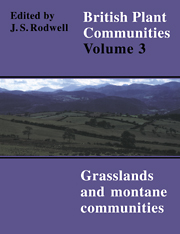Book contents
- Frontmatter
- Contents
- List of Figures
- Preface and Acknowledgements
- Preamble
- Mesotrophic Grasslands
- Community Descriptions
- Calcicolous Grasslands
- Community Descriptions
- Calcifugous Grasslands and Montane Communities
- Community Descriptions
- Index of Synonyms to Grasslands and Montane Communities
- Index of Species in Grasslands and Montane Communities
- Bibliography
Key to Calcifugous Grasslands and Montane Communities
Published online by Cambridge University Press: 04 July 2020
- Frontmatter
- Contents
- List of Figures
- Preface and Acknowledgements
- Preamble
- Mesotrophic Grasslands
- Community Descriptions
- Calcicolous Grasslands
- Community Descriptions
- Calcifugous Grasslands and Montane Communities
- Community Descriptions
- Index of Synonyms to Grasslands and Montane Communities
- Index of Species in Grasslands and Montane Communities
- Bibliography
Summary
With something as complex and variable as vegetation, no key can pretend to offer an infallible short cut to diagnosis. The following should therefore be seen as a crude guide to identifying the types of calcifugous grassland and montane vegetation in the scheme and must always be used in conjunction with the data tables and community accounts. It relies on floristic (and, to a lesser extent, physiognomic) features of the vegetation and demands a knowledge of the British vascular flora and some bryophytes and lichens. It does not make primary use of any habitat features, although these can provide a valuable confirmation of a diagnosis.
Because the major distinctions between the vegetation types in the classification are based on inter-stand frequency, the key works best when sufficient samples of similar composition are available to construct a constancy table. It is the frequency values in this (and, in some cases, the ranges of abundance) which are then subject to interrogation with the key. Most of the questions are dichotomous and notes are provided at particularly difficult choices or where confusing mosaics and zonations are likely to be encountered.
Samples should always be taken from homogeneous stands and be of 2 × 2 m or 4 × 4 m according to the scale of the vegetation or, where complex patterns occur, of identical size but irregular shape. Very small stands can be sampled in their entirety.
1 Open or closed grassy swards dominated by one or more of Festuca ovina, Agrostis capillaris, A. curtisii or Deschampsia flexuosa with Galium saxatile and Potentilla erecta often common; Nardus stricta, Deschampsia cespitosa, Juncus squarrosus and Carex bigelowii usually occasional at most but, even if frequent, then not present in any abundance 2
F. ovina, A. capillaris, A. curtisii and D. flexuosa can be frequent but typically subordinate in cover 15
2 Generally closed swards dominated by either D. flexuosa or A. curtisii, often with a little Calluna vulgaris’, F. ovina and A. capillaris can be frequent but always subordinate in cover 3
D. flexuosa and A. curtisii can occur but never as overwhelming dominants 5
- Type
- Chapter
- Information
- British Plant Communities , pp. 289 - 298Publisher: Cambridge University PressPrint publication year: 1992



